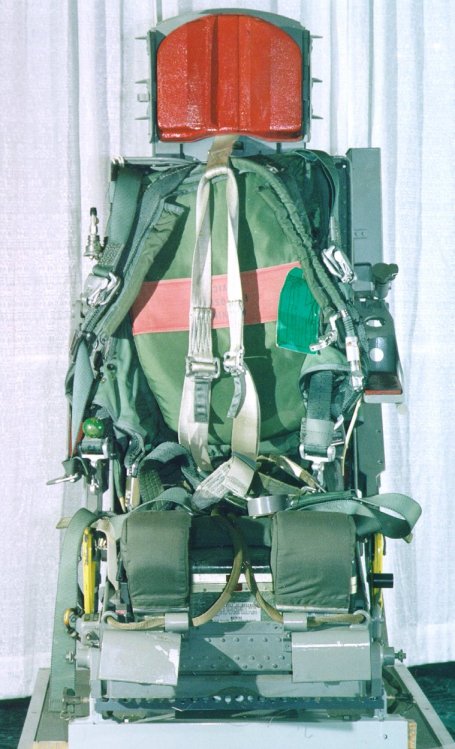 This seat is an example of a 2nd Generation ejection seat. This seat used a Rocket/Catapult ROCAT system and was fully automated.
This seat is an example of a 2nd Generation ejection seat. This seat used a Rocket/Catapult ROCAT system and was fully automated.
This seat, used late in the Vietnam War shows many upgrades over the earlier seats fitted to the F-105. The headrest has been reinforced and leg restraint lines fitted for examples. Another major modification is the incorporation of the Weber Force Deployed parachute system. Note the red band across the parachute backpad to indicate there is a drogue gun installed.
Another example of this seat can be seen here. The other seat has the lower leg protective plate in the deployed position, and the garters fitted to the leg restraint lines.
A small note about the displayed seat- the ROCAT hanging from the attach point is a CKU-7 ROCAT normally fitted to the Northrop T-38 seat. It was placed on this seat accidentally, and should not be considered to be accurate.
| 3/4 Right view Note the large bolt at the front edge
of the seat pan. This is the pivot point for the leg plate which is stowed flat under the seat until ejection. |
| Right side view |
| 3/4 Rear right view |
| Rear view |
| 3/4 Left view Note the large routing tubes for the
leg restraint lines. These lines would be attached to garters worn by the aircrew. The bent sheet-metal plates underneath these tubes would prevent them from digging into the backs of the aircrewman's thighs on ejection. |
| Left side view Note the Weber parachute actuator above the left armrest (which is unstowed here). |
| Closeup of the Weber parachute actuator connected to the ballistically deployed parachute. |
This ejection seat was on display at theSAFE Association History of Escape Systems and the Evolution of Manikins Display during the SAFE Association 40th annual Symposium, October 2002
| The Ejection Site Home | |
|---|---|
| Send email to Kevin |